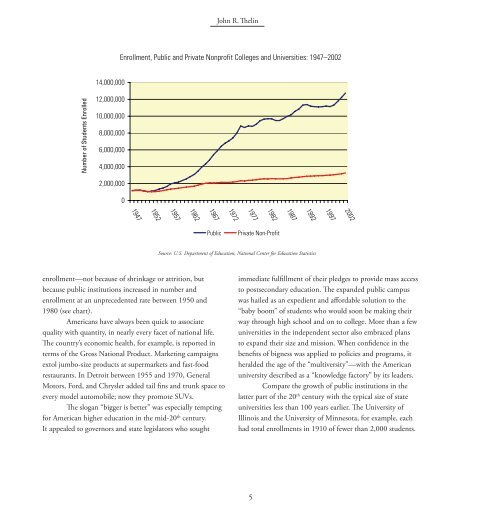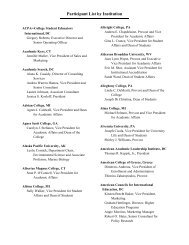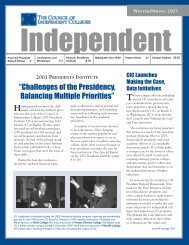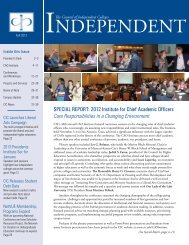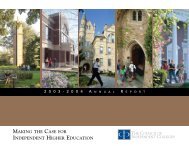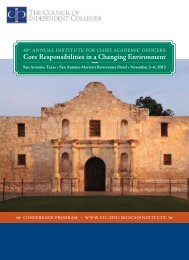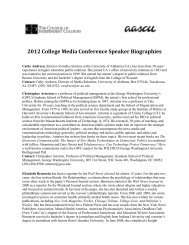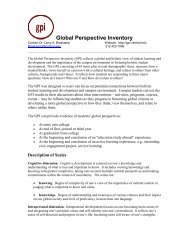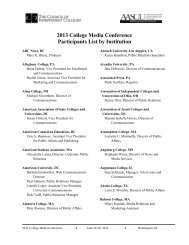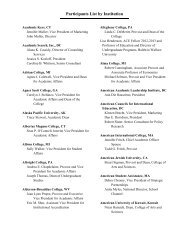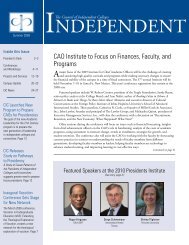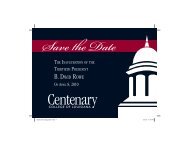Meeting the Challenge: - The Council of Independent Colleges
Meeting the Challenge: - The Council of Independent Colleges
Meeting the Challenge: - The Council of Independent Colleges
Create successful ePaper yourself
Turn your PDF publications into a flip-book with our unique Google optimized e-Paper software.
John R. <strong>The</strong>lin<br />
Enrollment, Public and Private Nonpr<strong>of</strong>it <strong>Colleges</strong> and Universities: 1947–2002<br />
14,000,000<br />
Number <strong>of</strong> Students Enrolled<br />
12,000,000<br />
10,000,000<br />
8,000,000<br />
6,000,000<br />
4,000,000<br />
2,000,000<br />
0<br />
1947<br />
1952<br />
1957<br />
1962<br />
1967<br />
1972<br />
1977<br />
1982<br />
1987<br />
1992<br />
1997<br />
2002<br />
Public<br />
Private Non-Pr<strong>of</strong>it<br />
Source: U.S. Department <strong>of</strong> Education, National Center for Education Statistics<br />
enrollment—not because <strong>of</strong> shrinkage or attrition, but<br />
because public institutions increased in number and<br />
enrollment at an unprecedented rate between 1950 and<br />
1980 (see chart).<br />
Americans have always been quick to associate<br />
quality with quantity, in nearly every facet <strong>of</strong> national life.<br />
<strong>The</strong> country’s economic health, for example, is reported in<br />
terms <strong>of</strong> <strong>the</strong> Gross National Product. Marketing campaigns<br />
extol jumbo-size products at supermarkets and fast-food<br />
restaurants. In Detroit between 1955 and 1970, General<br />
Motors, Ford, and Chrysler added tail fins and trunk space to<br />
every model automobile; now <strong>the</strong>y promote SUVs.<br />
<strong>The</strong> slogan “bigger is better” was especially tempting<br />
for American higher education in <strong>the</strong> mid-20 th century.<br />
It appealed to governors and state legislators who sought<br />
immediate fulfillment <strong>of</strong> <strong>the</strong>ir pledges to provide mass access<br />
to postsecondary education. <strong>The</strong> expanded public campus<br />
was hailed as an expedient and affordable solution to <strong>the</strong><br />
“baby boom” <strong>of</strong> students who would soon be making <strong>the</strong>ir<br />
way through high school and on to college. More than a few<br />
universities in <strong>the</strong> independent sector also embraced plans<br />
to expand <strong>the</strong>ir size and mission. When confidence in <strong>the</strong><br />
benefits <strong>of</strong> bigness was applied to policies and programs, it<br />
heralded <strong>the</strong> age <strong>of</strong> <strong>the</strong> “multiversity”—with <strong>the</strong> American<br />
university described as a “knowledge factory” by its leaders.<br />
Compare <strong>the</strong> growth <strong>of</strong> public institutions in <strong>the</strong><br />
latter part <strong>of</strong> <strong>the</strong> 20 th century with <strong>the</strong> typical size <strong>of</strong> state<br />
universities less than 100 years earlier. <strong>The</strong> University <strong>of</strong><br />
Illinois and <strong>the</strong> University <strong>of</strong> Minnesota, for example, each<br />
had total enrollments in 1910 <strong>of</strong> fewer than 2,000 students.<br />
5


